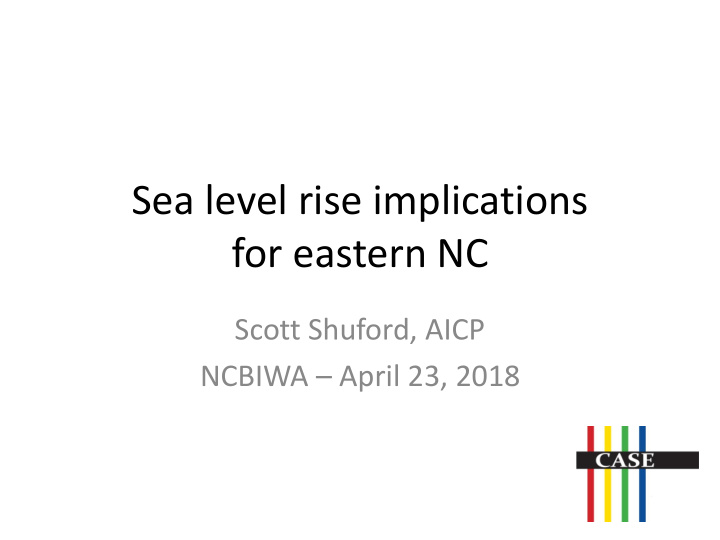



Sea level rise implications for eastern NC Scott Shuford, AICP NCBIWA – April 23, 2018
About me • Planning consultant – CASE Consultants International • IPCC FAR – 2007 – Hired by NOAA/UNCA – Co-author of APA PAS report • Co-author of APA Climate Change Policy Guide
Causes of sea level rise • Thermal expansion • Melting of land-based ice (glaciers, ice sheets) • Subsidence • Changes to ocean currents
Sea level rise in NC 48.5 cm or ~19 inches Federal Department of Transportation 4
Sea level rise in NC Graphics courtesy of The Nature Conservancy 2 feet 5
Sea level rise in NC One meter (~40”) of SLR 6
Sea level rise in NC – 6 feet NOAA’s SLR Viewer at 6 feet of SLR
Historic sea levels Note the stable SL over the last 4,000 years in London Geological Society the graph above
Historic sea levels USGS figure from handout brochure
Historic sea levels This figure shows the shoreline 20,000 years ago prior to a 125 meter rise to current SL. Note that the shoreline was at the continental shelf off the NC coast.
Historic sea levels This figure shows the shoreline during the Pliocene Era 3M years ago when global temperatures were 2-3 degrees Celsius above current temps. The SL then was 30 m KEY higher than today. Orangeburg Scarp The Paris Accord is trying to hold global temperature rise below 2 degrees City of Fayetteville Celsius. USGS
SLR is more than just inundation • Storm surge magnification • Salt water intrusion • Disruption of ocean outflows (e.g., rivers, drainage ditches) • Infrastructure degradation • Insurance – availability and affordability
Adaptive responses • Evaluate “risk” – “Risk” is your level of exposure to an event relative to the likelihood of that event happening – For SLR, exposure is significantly related to elevation above sea level and to time – SLR is extremely likely and its impacts will increase over time but its extent is not certain • Respond accordingly to the level of risk, based on client/community tolerance for risk and best information available
Adaptive responses Greater exposure Less exposure Project is long-term Project is short-term Project is more costly Project is less costly Project is lower elevation Project is higher elevation
Adaptive responses DOD The US Naval Yards and the City of Norfolk have major exposure to SLR.
Adaptive responses The Confederation Bridge in Canada was built with anticipation of a meter of SLR. The subway grate riser protects subways from street flooding while providing amenities like seating and a bike rack. 16
Decision-making • Beach nourishment project – 5-10 life span • Seawall – 50 year life span • Paved road – 20-30 year life span • Rail line – 50+ year life span • Sewage treatment plant – 70 year life span • Major bridge – 100 year life span Project decision making should take into account how much SLR will occur over the life span of the particular project.
Planning ahead • Retreat • Fortification Planning for the future must include large scale actions to address SLR • Abandonment depending on the projected extent of potential impacts. • Migration – Industries (tourism, farming, etc.) – Residents
Conclusions • SLR will significantly reshape coastal NC regardless of its ultimate extent • It will be necessary to evaluate adaptive responses using risk-based analysis • Difficult choices will be required; these choices should be informed by the best available data, but there will always be an element of uncertainty
CONTACT INFORMATION Scott Shuford CASE Consultants International shuford@caseconsultantsinternational.com 828-450-0388
Recommend
More recommend